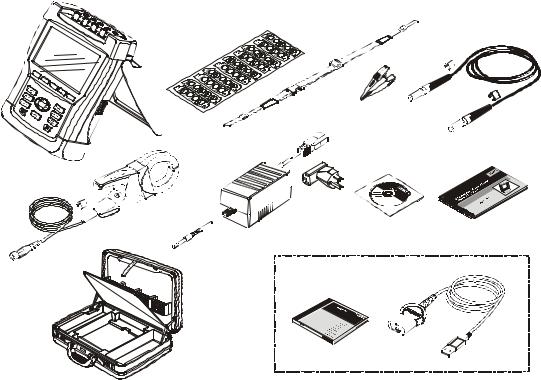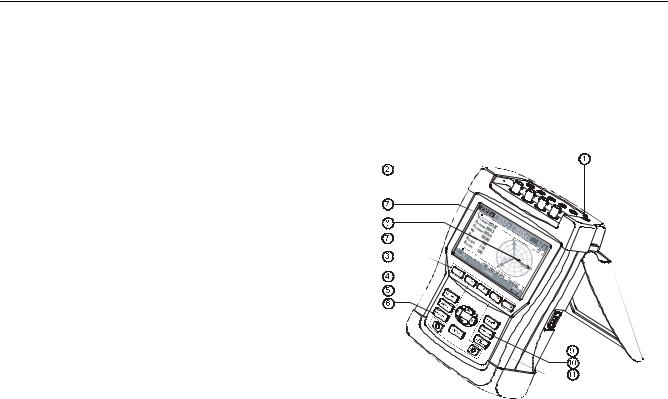Fluke 434, 433 User Manual

®
Fluke 433/434
Three Phase Power Quality Analyzer
Getting Started
EN
August 2004
© 2004 Fluke Corporation, All rights reserved. Printed in The Netherlands All product names are trademarks of their respective companies.

Contents of Analyzer Kit
F1
F2
F3
F4
F5
Fluke 434
Introduction
This Getting Started manual provides basic information on the Fluke 433 and 434 Three Phase Power Quality Analyzers. Fluke 434 has additional features such as Interharmonics, Transients, Energy Usage, Inrush Currents, extra memory to store Screens and Data, FlukeView software, and an optical isolated interface cable.
For complete operating instructions, refer to the Users Manual on the accompanying CD-ROM.
Contacting a Service Center
To locate a Fluke authorized service center, visit us on the World Wide Web at: www.fluke.com or call Fluke using any of the following phone numbers:
+1-888-993-5853 in the U.S. and Canada +31-40-2675200 in Europe +1-425-446-5500 from other countries.
Getting Started
Safety Information: Read First
The Fluke 433/434 Three Phase Power Quality Analyzer - hereafter referred to as “Analyzer” - complies with:
•ANSI/ISA S82.01-1994.
•EN/IEC61010-1 2nd edition 1000 V Measurement Category III, 600 V Measurement Cat IV, Pollution Degree 2.
•CAN/CSA-C22.2 No.61010-1-04 (including approval).
Use the Analyzer and its accessories only as specified in the Users Manual. Otherwise, the protection provided by the Analyzer and its accessories might be impaired.
A Warning identifies conditions and actions that pose hazard(s) to the user.
A Caution identifies conditions and actions that may damage the Analyzer.
1

Fluke 433/434
Getting Started
 Warning
Warning
To avoid electrical shock or fire:
•Review the entire manual before use of the Analyzer and its accessories.
•Avoid working alone.
•Do not operate the Analyzer around explosive gas or vapor.
•Use only insulated current probes, test leads and adapters as supplied with the Analyzer, or indicated as suitable for the Fluke 433/434 Analyzer.
•Before use, inspect the Analyzer, voltage probes, test leads and accessories for mechanical damage and replace when damaged. Look for cracks or missing plastic. Pay special attention to the insulation surrounding the connectors.
•Remove all probes, test leads and accessories that are not in use.
•Always connect the Battery Charger / Power Adapter first to the AC outlet before connecting it to the Analyzer.
•Use the ground input only to ground the Analyzer and do not apply any voltage.
•Do not apply input voltages above the rating of the instrument.
•Do not apply voltages in excess of the marked ratings of the voltage probes or current clamps.
•Do not use exposed metal BNC or banana plug connectors.
•Do not insert metal objects into connectors.
•Use only the power supply, Model BC430 (Battery Charger / Power Adapter).
•Before use check that the selected/indicated voltage range on the BC430 matches the local line power voltage and frequency. If necessary set the slider switch of the BC430 to the correct voltage.
•For the BC430 use only AC line plug adapters or AC line cords that comply with local safety regulations.
 Max. Input Voltage at Voltage Banana Inputs to ground:
Max. Input Voltage at Voltage Banana Inputs to ground:
Input A (L1), B (L2), C (L3), N to GND: ..........................
.......................................... 1000 V Cat III, 600 V Cat IV
 Max. Voltage at Current BNC Inputs (See marking):
Max. Voltage at Current BNC Inputs (See marking):
Input A (L1), B (L2), C (L3), N to GND: .......... |
42 V peak |
2

Getting Started
If Safety Features are Impaired
Voltage ratings are given as “working voltage”. They should be read as V ac rms (50-60 Hz) for AC sine wave applications and as V dc for DC applications.
Measurement Category IV refers to the overhead or underground utility service of an installation. Cat III refers to distribution level and fixed installation circuits inside a building.
Note
Before use, inspect the test leads for mechanical damage and replace damaged test leads!
If the Analyzer or its accessories appear to be impaired or not functioning properly, do not use it and send it in for repair.
Reference to Manual Sections
To accommodate connection to various line power sockets, the BC430 Battery Charger / Power Adapter is equipped with a male plug that must be connected to a line plug adapter appropriate for local use. Since the Charger is isolated, you can use line plug adapters with or without a protective ground terminal.
The 230 V rating of the BC430 is not for use in North America. A line plug adapter complying with the applicable National Requirements may be provided to alter the blade configurations for a specific country.
If Safety Features are Impaired
If the Analyzer is used in a manner not specified by the manufacturer, the protection provided by the Analyzer may be impaired.
3

Fluke 433/434
Getting Started
|
|
|
Subject |
Page |
|
|
|
|
|
c |
Charging Batteries, Preparing for Use. |
4 |
||
|
|
|
|
|
d |
Input Connections. |
7 |
||
|
|
|
|
|
e |
Auxiliary Functions, Menu Navigation. |
5 |
||
|
|
|
|
|
f |
SCOPE Mode. |
8 |
||
|
|
|
|
|
g |
Measurements MENU. |
8 |
||
|
|
|
|
|
h |
Power Quality MONITOR. |
9 |
||
|
|
|
|
|
i |
Screen Symbols. |
10 |
||
|
|
|
|
|
j |
Screens and Function Keys. |
10 |
||
|
|
|
|
|
k |
Setting up the Analyzer, SETUP. |
16 |
||
|
|
|
|
|
• |
MEMORY Use. |
18 |
||
|
|
|
|
|
|
|
|
SAVE Screens. |
17 |
|
|
|
||
|
|
|
|
|
Charging the Batteries and Preparing for Use
At delivery, the installed rechargeable NiMH batteries may be empty. To reach full charge they must be charged for 4 hours with the Analyzer turned off:
•use only the supplied Battery Charger/Power Adapter model BC430.
•before use check that the BC430 voltage and frequency range match the local line power range (refer to figure below). If necessary set the slider switch of BC430 to the correct voltage.
•connect the battery charger to the AC outlet.
•connect the battery charger to the POWER ADAPTER input on the top side of the Analyzer.
|
|
|
|
115V |
|
230V |
|
|
|
|
|
|
|
|
|
|
|
|
|
||
|
|
|
|
|
|
|
|
|
|
|
|
|
|
|
|
|
|
|
|
|
|
Caution
Before making any measurements, set the Analyzer up for the line voltage, frequency, and wiring configuration of the power system you want to measure. This is explained in section ‘Setting up the Analyzer’.
To obtain maximum capacity of the battery, charge the batteries at least twice a year.
When using your Analyzer for the first time, you must set it up for the measurements you want to make. Section ‘Setting up the Analyzer’ gives an overview of items to be adjusted.
4
